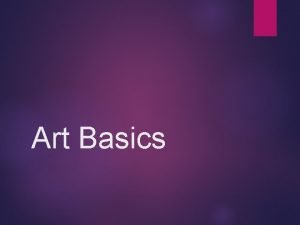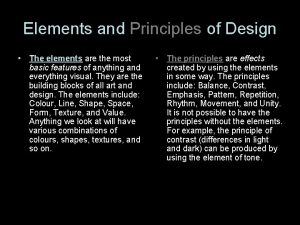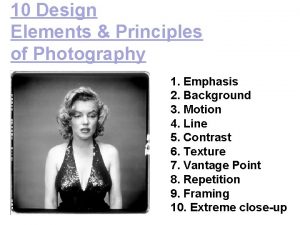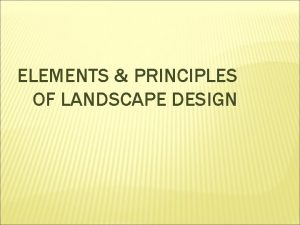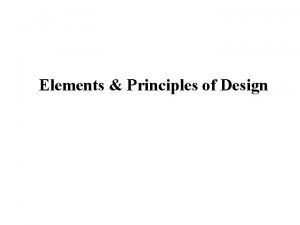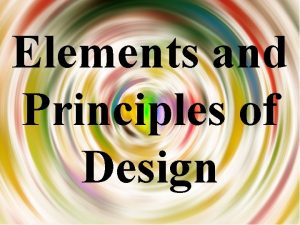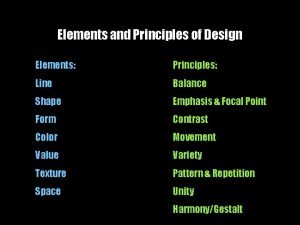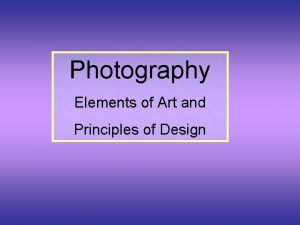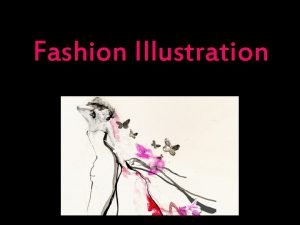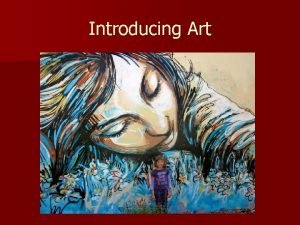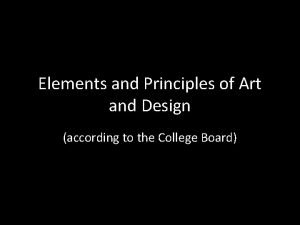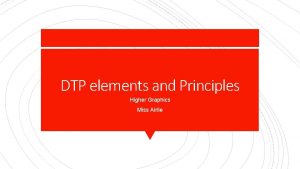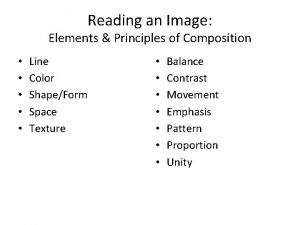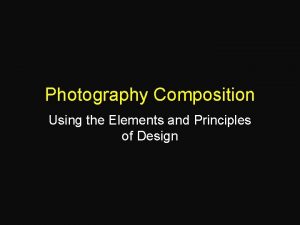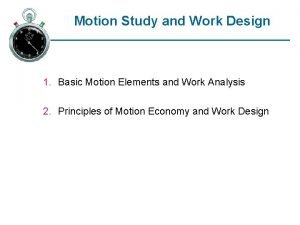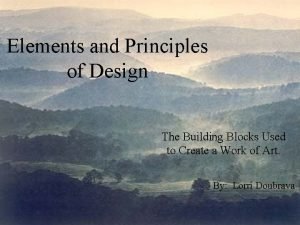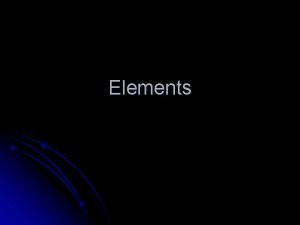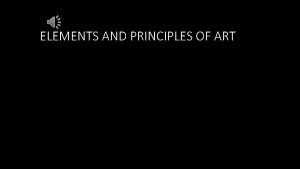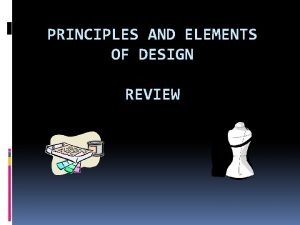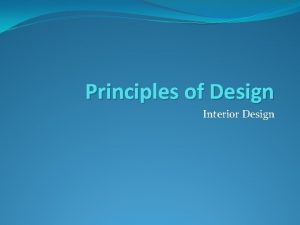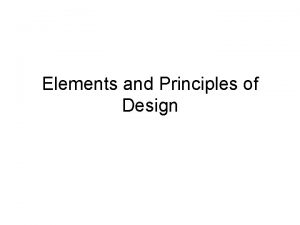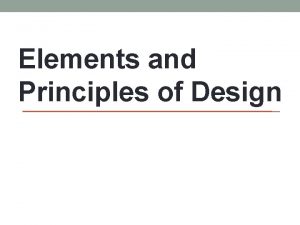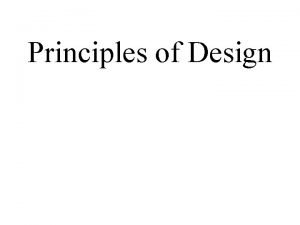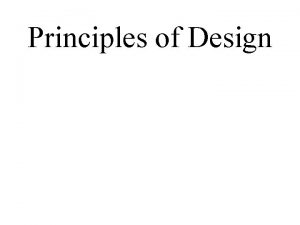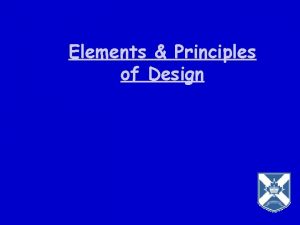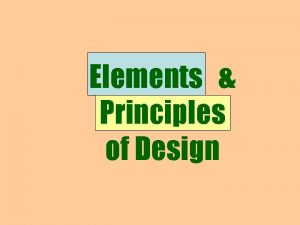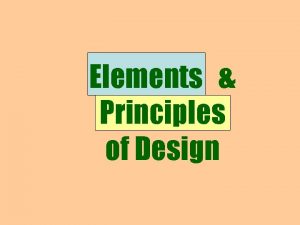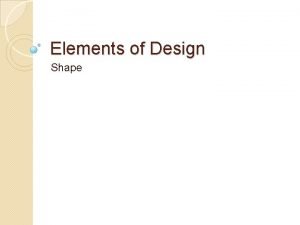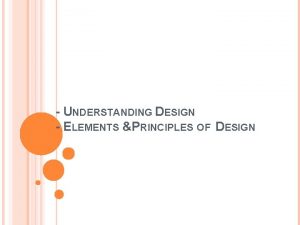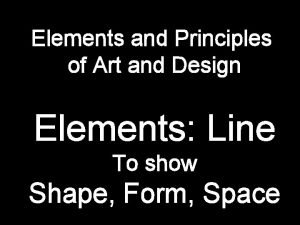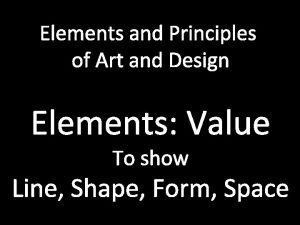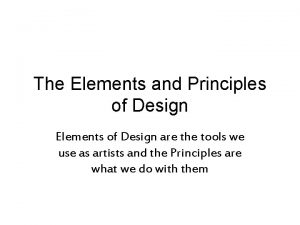Elements The Elements and Principles of Design l





































































- Slides: 69

Elements

The Elements and Principles of Design l The elements of design are the basic ingredients or building blocks of art l A visual language to understand respond to art Untitled (Green, Red on Orange), 1951 Mark Rothko

The Elements l l Line: the mark left by a point moving continuously through space There can be many ways to describe lines: horizontal, vertical, curved, straight, painted, pencil drawn, thick, thin, etc The Scream, 1895 Edvard Munch

l l l Upper Left: Uniform vertical black and white lines alternate at even intervals. Static. Orderly. Conservative. Upper Right: Uniform horizontal black lines are widely, but evenly spaced. Static. Stable. Orderly. Middle Left: Uneven spacing of otherwise uniform lines creates the impression of movement. Dynamic. Orderly progression. Middle Right: In this example the progression moves in from either side giving the illusion of roundness. Dynamic. Orderly progression. Dimension. Lower Left: Varying line widths and distances create a random pattern. Dynamic. Chaotic. Disorderly. Lower Right: While the uniform size and spacing of the lines in the upper examples are static, make the lines into curves and you get movement although it is a controlled movement. Dynamic. Orderly flow.


Line Direction The direction of a line can convey mood. l Horizontal lines are calm and quiet, . l

l vertical lines suggest more of a potential for movement, l while diagonal lines strongly suggest movement and give more of a feeling of vitality to a picture

Contour and gesture l Lines used to follow the edges of forms are called contour drawings l Drawings which seem to depict more movement than actual outline are called gesture drawings

Line as Value l Lines or crosshatching can also be used to create areas of grey inside a drawing. These areas of darker shading inside a figure, called areas of value, can give a more three-dimensional feeling to an object. l Drawing by Marguerite Smith, Saskatoon


The Elements l l l Shape: An area clearly set off by one or more of the other elements such as colour, value, line, or texture ex. Square, leaf Form: an object with three dimensions. Ex, sphere, tree. Both can be geometric or organic Annunciation Greek Orthodox Church Wauwatosa, Wisconsin 1956 Franklin Lloyd Wright

Positive/Negative (space) l In a picture, the shapes that the artist has placed are considered the positive shapes. The spaces around the shapes are the negative spaces. It is just as important to consider the negative space in a picture as the positive shapes. Sometimes artists create pieces that have no distinction between positive and negative spaces. M. C. Escher was a master at creating drawings where there was no distinction between positive and negative space.

geometric vs organic l Abstract vs realistic l

perspective & shape l size: larger objects appear closer, smaller shapes appear farther away. l l vertical location: higher objects appear farther away

l Look at the shapes. There are no colors, yet many people will understand what these shapes mean or represent

psychology of shapes circle = protective or infinite l also, eternity, connection, community, wholeness, endurance, movement, safety, perfection, power, energy, integrity, perfection, completeness, home, restriction l refers to the feminine: warmth, comfort, sensuality, and love, wholeness and unity l l

l l square = stability, equality, solidity, security, rationality and honesty triangle = tension or conflict or action also, energy, power, balance, law, science, religion. refers to the masculine: strength, aggression, dynamic movement, selfdiscovery and revelation

l Spiral-expressions of creativity, process of growth and evolution


The Elements l l Texture: the tactile quality of things, appealing to our sense of touch – surface quality Can be real or simulated (made to look real) Object: Luncheon in Fur (1936) Meret Oppenheim

l l l Paul Klee (French) 18791940, Ad Parnassem, 1932 , Oil on canvas, 39 x 49 in Klee (pronounced "clay") adds the texture to make the work visually interesting. The colors and lines of the work are extremely simple. The added texture adds detail The entire surface of this painting is covered in thick, rectangular brushstrokes of color

l Texture is related to value, in that it’s created by modifying the light on a surface (review the element of VALUE). We don’t need to touch a shiny silver bowl to know its surface is hard, smooth, and polished. But we can “sense” a crumpled piece of paper’s texture because of the hundreds of broken, abrupt value changes. In sculpture, hammering, carving, embossing or molding the surface of the material adds texture.


The Elements l l l Space: the distance or area between, around, above, below, or withings 3 ways to Create space: linear perspective, overlapping and atmosphere Can be describe in terms of Positive or Negative

Linear perspective l is a geometric, mathematical method using receding lines called orothogonals that move toward a vanishing point. In this illustration, you can see how edges of the box that are drawn along these orthogonals appear to create a realistically three-dimensional object. In ladder perspective figures at the top of the page seem to be further away, and are sometimes smaller in scale than things that are closer to enhance the illusion. You can see ladder perspective used in children’s drawings and in this artwork based on the early art of Stone Age hunters.

l Creating art involves an interplay between positive space, the object, and negative space, the background. Use the illusion in the vase and faces picture here to examine positive and negative space

Apples, 1878– 79 Paul Cézanne (French, 1839– 1906)Oil on canvas; 9 x 13 in. (22. 9 x 33 cm) Observe the shadows and highlights on the fruit.

Composition l Rule of thirds: Note how the horizon falls close to the bottom grid line, and how the dark areas are in the left third, the overexposed in the right third The rule of thirds is a guideline commonly followed by visual artists. The objective is to stop the subject(s) and areas of interest (such as the horizon) from bisecting the image, by placing them near one of the lines that would divide the image into three equal columns and rows, ideally near the intersection of those lines.

The Elements l Colour: Element of art produced when a wavelength of light strikes an object and reflects back to the eyes 1. 2. 3. Hue, the colour name Intensity, brightness or purity Value, lightness or darkness of colour Green Stripe, 1905 Henri Matisse

The Principles of Design The rules or strategies artists use to organize the Elements of Design l Each principle describes a unique way of combining the elements to achieve different effects l If the elements are like building blocks, than the principles are like the rules of construction used to make a structurally sound aesthetically pleasing house l

Balance l l In artworks, balance is a visual feeling of weight Formal or symmetrical balance Informal or asymmetrical balance Radial


l Not balanced Balanced

Variety l l Variety: The use of different lines, shapes, textures, colors and other elements of design to create interest in a work of art. Variety emphasizes differences or opposites Halifax Print, Gene Davis

Contrast or Variety l Principle of Design concerned with difference or contrast. An artwork which makes use of many different hues, values, lines, textures, and shapes would reflect the artist's use of variety.



Emphasis l l l The principle of art that directs and centers our attention on one significant part of the artwork This focal point is the object or area that is dominant over the others Contrast is often used to achieve emphasis Self Portrait, 1630 Judith Leyster

l l l l • Artists use emphasis to help unify a work of art. • Emphasis controls the sequence in which the parts are noticed. • It also controls the amount of attention a viewer gives to each part. • There are two main types of emphasis in a work of art: 1. An element of art dominates the entire work. 2. An area of work is dominate over all the others. – An artist can create an dominate area by: – Contrast – Isolation – Location – Convergence – The Unusual

l l l l l Emphasizing an Element • If the artist chooses to emphasizes one element, all the other elements of the work are made subordinate, or less important. • The dominate, or most important, element affects the viewer’s perception of the total work. • Sometimes the dominate element is so strong that the whole work seems to be drenched in the element.

• Robert Rauschenberg. Red Painting. 1953. Oil, cloth, and newsprint on canvas with wood. 79 x 33 1/8”. The Soloman R. Guggenheim Museum, New York. Gift, Walter K. Gutman, 1963. Copyright Robert Rauschenberg/Licensed by VAGA, New York, NY. l l l • Robert Rauschenberg’s Red Painting is saturated with the color red. • Even though he has used a variety of textures to create different areas, the redness takes on a meaning all its own. • It affects the viewer’s perception of the separate parts of the work. • Many different values of red are present in this work. In this way, the artist has created variety and added interest to a painting that might otherwise be boring.

l l l l l Emphasizing an Area • Sometimes a specific area in a work of art is emphasized. This area, called the focal point, is the first part of a work to attract the attention of the viewer. • The other area are subordinate to the focal point. • It is possible for a work of art to have more than one focal point. • Rembrandt used value like a spotlight to emphasize one important area - a focal - in his paintings.

• The artist has used value contrast to create a focal point in this work. Only the head and the area immediately around it are painted in light values. The background sinks into the darkness. Rembrandt van Rijn (workshop of). Portrait of Rembrandt. 1650. Oil on canvas. 36 1/4 x 29 1/4”.


Harmony/ Unity l l l Harmony: Combining similar elements in an artwork to accent their similarities Harmony is created through the use of repetition and subtle, gradual changes Colour is a common way to create Unity Composition 8, 1914 Piet Mondrian

l l l Proximity The simplest method of making objects appear to belong together is to group them closely together. This allows us to see a pattern. Repetition Another method often used to promote unity is the use of repetition. Repetition of color, shape, texture or object can be used to tie a work together Continuation A much more subtle method of unifying a work involves the continuation of line, edge or direction from one area to another. Continuation is often used in books and magazines to tie the elements of a page together with the use of rules, and by lining up edges of copy, headlines and graphics

Rhythm l l l Rhythm is a regular or harmonious pattern that repetition of lines, shapes and colours creates the look and feeling of action A visual tempo or beat Rhythm guides the viewer’s eye through the work or to the focal point At Northern Bay Sands, 1992 K. M. Graham

Movement + pattern = Rhythm l Rhythm refers to the way your eye moves throughout a picture Look at the two images above. The painting by Matisse [1] is full of sweeping circular areas which move your eye around the picture (it is a good example of optical movement). The elements are flowing and circular and give you the impression of a calm quiet rhythm. The line drawing on the right is more dynamic due to its incomplete nature and the feeling of motion is much more evident

Rhythm is the repetition or alternation of elements, often with defined intervals between them. Rhythm can create a sense of movement, and can establish pattern and texture. There are many different kinds of rhythm, often defined by the feeling it evokes when looking at it. l Regular: A regular rhythm occurs when the intervals between the elements, and often the elements themselves, are similar in size or length. l Flowing: A flowing rhythm gives a sense of movement, and is often more organic in nature. l Progressive: A progressive rhythm shows a sequence of forms through a progression of steps.

Progressive Rhythm Transformations by M C Escher


l l The diagrams on the right show abstract patterns. The top diagram has little rhythm - the eye darts from one circle to another trying to find a pattern. It creates a restless and confusing design. The circles in the bottom diagram have been arranged so that the eye moves from one to another in a smooth, effortless way. This has a better sense of rhythm.

Movement l Movement is the path our eyes follow when we look at a work of art. The purpose of movement is to create unity in the artwork with eye travel. This can be achieved by using repetition, rhythm, and action. Movement ties the work together by relating the various components of a work together.



Movement Dynamism of a Dog on a Leash by Giacomo Balla 1912 Oil on Canvas The many repetitions of the legs, feet, tail, and chain in this work give it the appearance of actual movement.

Pattern

Pattern Work by Henri Matisse that uses a lot of pattern

How has the artists use of pattern enhanced this piece? Would this piece be as interesting if the artist had used a solid background rather than this patterned one? Riffs by Florene

What elements has the artist used in this mask to create pattern? This decorative wall plaque is a great example of how an artist uses lines and shapes to create patterns. Artist Unknown, Indonesian, Wall Plaque,

Contrast l Contrast is a way of combining elements the stresses their differences


l size • value • color • type • texture • shape • alignment • direction • movement


Proportion The relationship in size of one component (part) of a work of art to another height, width and depth of one element to that of another size of one area to the size of another area size of one element to the size of another element amount of space between two or more elements


How is this artist, John Zacchea, showing correct proportion in Wine Bottle and Cheese? When comparing the size of the objects in the composition, you see that the objects are not too large or too small for each other. They are of a realistic size.

Facial Proportions

Examples of Contemporary Artists who distort proportion.
 Parallel lines in a hairstyle
Parallel lines in a hairstyle Five elements of hair design
Five elements of hair design Principles of floral design
Principles of floral design Elements and principles of design chart
Elements and principles of design chart Principles of design in interior design ppt
Principles of design in interior design ppt It represents dignity formality, stability and strength
It represents dignity formality, stability and strength Da vinci
Da vinci Ci element
Ci element Elements and principles of design space
Elements and principles of design space Elements and principles in photography
Elements and principles in photography Elements of design in architecture
Elements of design in architecture Elements and principles of landscape design
Elements and principles of landscape design What are the elements and principles of design
What are the elements and principles of design Christina's world
Christina's world Visual elements and principles of design
Visual elements and principles of design Elements and principles of photography
Elements and principles of photography Elements and principles of design fashion
Elements and principles of design fashion Hát kết hợp bộ gõ cơ thể
Hát kết hợp bộ gõ cơ thể Lp html
Lp html Bổ thể
Bổ thể Tỉ lệ cơ thể trẻ em
Tỉ lệ cơ thể trẻ em Chó sói
Chó sói Tư thế worm breton là gì
Tư thế worm breton là gì Chúa yêu trần thế alleluia
Chúa yêu trần thế alleluia Môn thể thao bắt đầu bằng chữ đua
Môn thể thao bắt đầu bằng chữ đua Thế nào là hệ số cao nhất
Thế nào là hệ số cao nhất Các châu lục và đại dương trên thế giới
Các châu lục và đại dương trên thế giới Cong thức tính động năng
Cong thức tính động năng Trời xanh đây là của chúng ta thể thơ
Trời xanh đây là của chúng ta thể thơ Mật thư anh em như thể tay chân
Mật thư anh em như thể tay chân Phép trừ bù
Phép trừ bù Phản ứng thế ankan
Phản ứng thế ankan Các châu lục và đại dương trên thế giới
Các châu lục và đại dương trên thế giới Thơ thất ngôn tứ tuyệt đường luật
Thơ thất ngôn tứ tuyệt đường luật Quá trình desamine hóa có thể tạo ra
Quá trình desamine hóa có thể tạo ra Một số thể thơ truyền thống
Một số thể thơ truyền thống Cái miệng nó xinh thế
Cái miệng nó xinh thế Vẽ hình chiếu vuông góc của vật thể sau
Vẽ hình chiếu vuông góc của vật thể sau Nguyên nhân của sự mỏi cơ sinh 8
Nguyên nhân của sự mỏi cơ sinh 8 đặc điểm cơ thể của người tối cổ
đặc điểm cơ thể của người tối cổ V. c c
V. c c Vẽ hình chiếu đứng bằng cạnh của vật thể
Vẽ hình chiếu đứng bằng cạnh của vật thể Phối cảnh
Phối cảnh Thẻ vin
Thẻ vin đại từ thay thế
đại từ thay thế điện thế nghỉ
điện thế nghỉ Tư thế ngồi viết
Tư thế ngồi viết Diễn thế sinh thái là
Diễn thế sinh thái là Dạng đột biến một nhiễm là
Dạng đột biến một nhiễm là Số.nguyên tố
Số.nguyên tố Tư thế ngồi viết
Tư thế ngồi viết Lời thề hippocrates
Lời thề hippocrates Thiếu nhi thế giới liên hoan
Thiếu nhi thế giới liên hoan ưu thế lai là gì
ưu thế lai là gì Hổ đẻ mỗi lứa mấy con
Hổ đẻ mỗi lứa mấy con Sự nuôi và dạy con của hươu
Sự nuôi và dạy con của hươu Hệ hô hấp
Hệ hô hấp Từ ngữ thể hiện lòng nhân hậu
Từ ngữ thể hiện lòng nhân hậu Thế nào là mạng điện lắp đặt kiểu nổi
Thế nào là mạng điện lắp đặt kiểu nổi Elements and principles of art
Elements and principles of art The relative thickness or thinness of a line is known as
The relative thickness or thinness of a line is known as Dtp elements
Dtp elements Elements and principles of composition
Elements and principles of composition The area used or unused in a composition
The area used or unused in a composition Motion study involves analysis of
Motion study involves analysis of Postmodern design principles
Postmodern design principles Elements and principles of art
Elements and principles of art Girl with a pearl earring principles of design
Girl with a pearl earring principles of design It is the path our eyes follow when we look at work of art
It is the path our eyes follow when we look at work of art Principles of art movement
Principles of art movement






